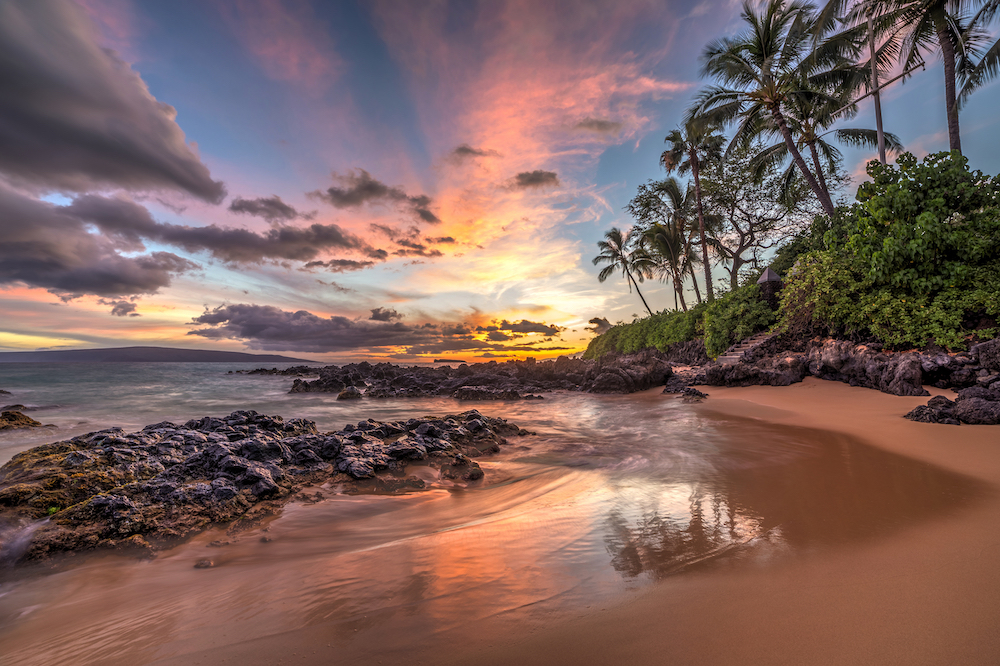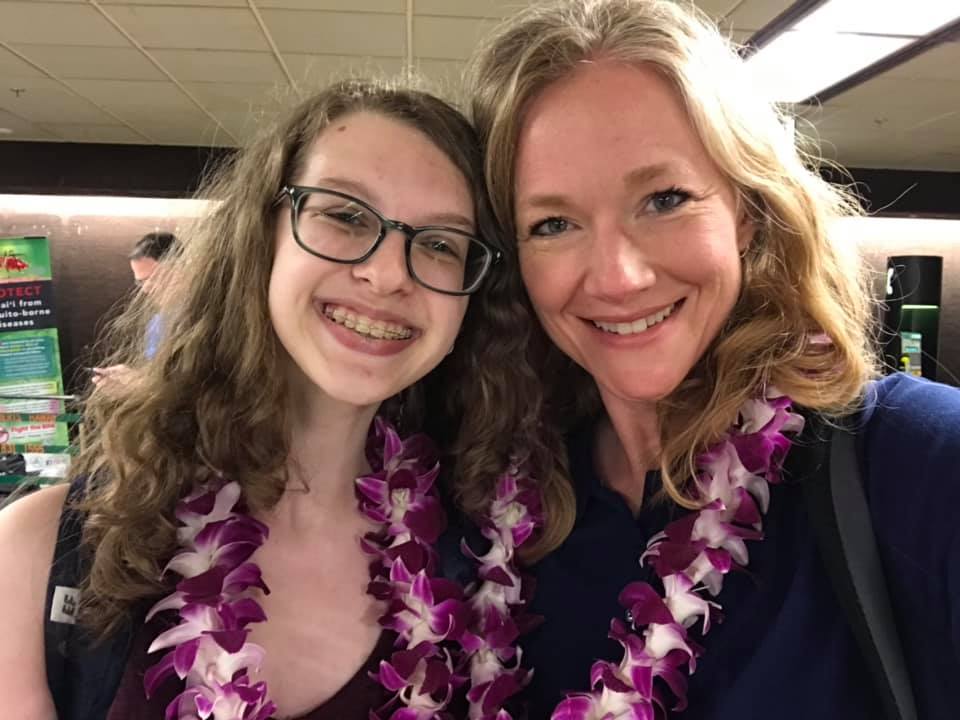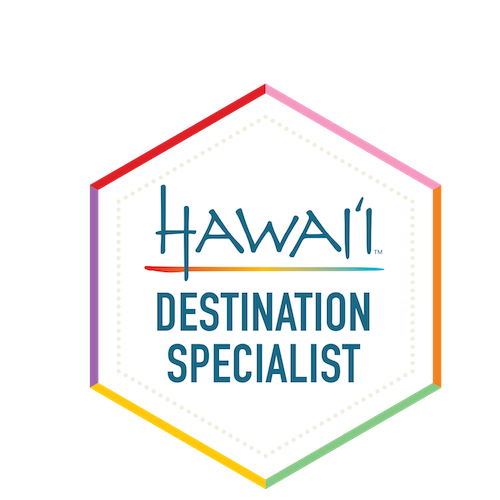Facts:
- Lana’i is the smallest publicly accessible island in the Hawaiian chain.
- Oracle co-founder Larry Ellison owns a 98% stake in the island that he bought for $300 million in 2012. He hopes to turn the island into a sustainable wellness laboratory.
- Lanai has no traffic lights, large buses, crowded beaches, malls, or city complexes – but it is known for its golf!
- The island is 18 miles at its longest with 47 miles of coastline – but only 1 readily accessible beach.
What is a lanai?
A lanai is the Hawaiian word for patio or balcony. Most hotel lanais come equipped with chairs and a small table. If you see the word spelled with an uppercase L, it refers to the Hawaiian island. If the word is spelled with a lowercase l, it refers to the balcony or patio.
Exploring Lanai
By Air
To get to Lanai, visitors must fly to Honolulu (Oahu) or Kahului (Maui) to connect to a local carrier. Lanai Airport (LNY) is a thirty-minute flight from Honolulu. Rental cars are available at the airport, and the resorts provide shuttle service between the hotels and the ferry landing on Manele Bay. Bicycles and off-road vehicles are for rent.
On Land
The best way to explore the rugged interior of Lanai is by four-wheel-drive vehicle or mountain bike. Many of the island’s landmarks are accessible only by dirt roads that require a four-wheel drive vehicle. Drivers and riders can expect to be covered with Lanai’s famous red dust after a day of off-road exploration. Guided jeep tours are also available.
By Sea
Passenger ferries connect Manele Harbor, Lanai with Lahaina, Maui. The Lahaina-Lanai Ferry provides service five times a day. The trip takes roughly an hour and can involve rough water.

Accommodation
Lanai offers 3 hotels and a few B&Bs.
Hotel Lanai
James Dole built the Hotel Lanai in Lanai City in 1923 as a lodge to house his pineapple plantation’s executive. The small hotel’s restaurant features American cuisine. Accommodations are rustic: the hotel’s plantation-style rooms have Hawaiian quilt bedcovers, ceiling fans, and hardwood floors. Reservations must be booked far in advance.
Sensei Lanai
The Four Seasons’ Sensei Lanai is designed as an English country manor in the cool uplands, outside of Lanai City. The resort features 102 rooms, fireplaces, spa services, golf, an executive putting course, horseback riding, archery and clay shooting, and some of Hawaii’s most decadent cuisine. The Koele Golf Course (formerly The Experience at Koele) is an upland course designed by Greg Norman and Ted Robinson. The first bent-grass course in Hawaii and one of three in the state, the course differs notably from the dry, oceanside Manele Golf Course.
Four Seasons Resort Lanai
The Four Seasons Resort Lanai in Manele Bay welcomes guests to its Mediterranean-Pacific beauty. It has 220 rooms and suites, restaurants, displays of art, a full service spa, tennis courts, and golf. Manele Golf Course (formerly The Challenge at Manele) borders the ocean and was designed by Jack Nicklaus.
Lanai’s resorts are ideal venues for weddings, honeymoons, and special occasions. Specially designed wedding packages ease all your pre-wedding jitters.
Location choices include barefoot vows on the beach; sunsets and fireworks on a cliff above the Pacific; sophistication in the ballroom with ocean and sky as the bride’s ‘something blue’; or a luau reception in the gardens by the shoreline.
Attractions
Lanai is divided into south, central, and north regions. Only the southern part has easily accessible beaches. The island’s key features include Hulopoe Bay on the south shore; Kaiolohia (Shipwreck Beach) in the northeast; Polihua Beach in the northwest; and Kaunolu, an ancient Hawaiian fishing village, on the southwest shore.
South Lanai
South Lanai is home to Hulopoe and Manele bays, marine life conservation areas where dolphins can be spotted jumping from the sea.
- Hulopoe Bay—Dolphins, fish, whales, and people share the island’s most inviting beach and marine sanctuary. The cove of white sand is Lanai’s destination for swimming, snorkeling, and tide pool exploration. Large tide pools carved out of volcanic rock are located on the eastern side of the bay. Most of the year, this bay fronting the Four Seasons at Manele Bay is the best spot for snorkeling and swimming. In the winter, swimmers should be aware of possible rough conditions.
- Puu Pehe (Sweetheart Rock)—Walk along the cliffs southeast of the tide pools to a view the Lanai landmark.
- Kaunolu—A fishing village at the southwest tip of the island where visitors can see the remains of King Kamehameha’s summer fishing retreat. Kaunolu is registered as a National Historic Landmark.
- Golf – Manele Golf Course (formerly The Challenge at Manele) at the Four Seasons Resort Lanai borders the ocean and was designed by Jack Nicklaus.
Central & West Lanai
- Kanepuu (kah neh poo oo) Preserve—Hawaii’s Nature Conservancy, the State Department of Land and Natural Resources, and a Lanai volunteer group work to preserve the state’s largest remnant of native olive and ebony, plus other unique plant species found only in Hawaii, several of which are endangered. Visitors can follow a self-guided trail that winds throughout the dry land forest and offers educational insight into Hawaii’s fragile ecosystems. The Nature Conservancy also provides guided hikes.
- Lanai City—The geographical and cultural center of the island, the town developed in the early 1900s as a plantation town for the pineapple industry.
- Lanaihale—A destination for experienced hikers who love a challenge, the island’s summit is the island’s coolest and greenest area. The Munro Trail leads to the top and can be biked, hiked, or driven (only in a 4WD vehicle).
- The hiking route is difficult and recommended for experienced hikers only. The terrain ranges from razor-backed cliffs and deep, sudden gulches to precarious perches above panoramic vistas.
- Luahiwa Petroglyphs—Pictographic figures are etched on the faces of boulders on a slope overlooking the dry Palawai Basin. The drawings reflect a mixture of ancient and recent styles.
North Lanai
- Kaiolohia Bay— The stretch of sand is called Shipwreck Beach because of the abandoned vessels visible on the reef. One was wrecked there while another was towed and left there after World War II. Visitors can reach Shipwreck Beach by 4WD or on foot after the paved road ends. The beach is good for beachcombing and fishing but not for swimming due to the reefs.
- Keahiakawelo (Garden of the Gods)— Sculpted over the course of hundreds of years by erosion, the rocks are some of Lanai’s most impressive natural attractions. Located on the north side of the island, approximately 7 miles from Lanai City, the rocks are most colorful at dusk when the setting sun casts an orange glow illuminating the formations in astonishing reds and purples.

Kimberly Brownlee is trained and experienced in travel to Hawai’i. Let her help you plan your trip of a lifetime!
Call or text 816.866.8883 or email Kimberly@NextAdventureVacations.com for more information
Related Pages:
animal kingdom Cancun Caribbean Disney Disney Cruise Line Disney Springs Disney Wish EPCOT Europe Fastpass fast passes Florence germany grandparents hawaii hollywood studios honolulu ireland Italy kansas city Magic Kingdom maui mediterranean Mexico missouri molokai Oahu packing tips planning restaurants Riviera Maya Romance Travel Rome Scotland teenagers travel tips travel with children travel with teens tropical vacation United Kingdom universal orlando Universal Resort Venice Walt Disney World Yucatan


